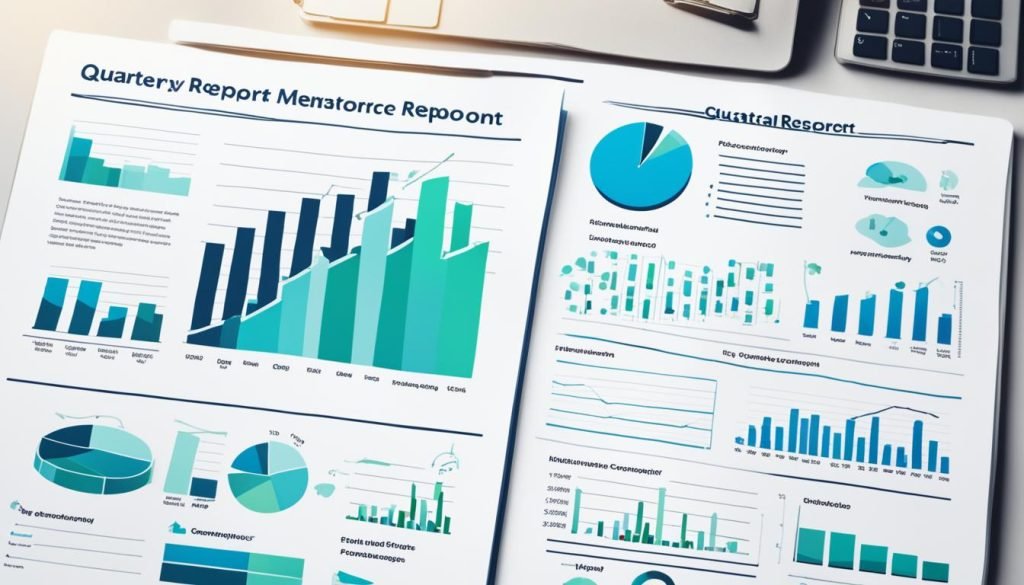Welcome to our guide on quarterly financial results and what they show about a company. In this article, we’ll look at how earnings reports, financial statements, and other data help us understand a company’s financial situation. By learning about these, you can make smarter choices in the financial world.
Key Takeaways:
- Quarterly financial results provide crucial information about a company’s financial health and performance.
- Earnings reports and financial statements offer insights into revenue growth trends and profit margins.
- Assessing cash flow overviews helps gauge a company’s liquidity and financial stability.
- Analyzing investment returns assessments aids in evaluating financial opportunities.
- Understanding these key insights enables informed decision-making for investors and stakeholders.
Understanding Quarterly Reports
Quarterly reports give a full look at how a company does in a certain quarter. They have unaudited financial statements like balance sheets. These statements are also reviewed by the SEC.
The reports also share other important info. This might be an overview of the company’s achievements and plans. Companies also tell others what they expect for their finances in the future.
People like analysts and investors really look at these reports. They check the key numbers to see how healthy the company is financially. These numbers cover things like sales, profit, and how well the company is making money.
By reading through these reports, investors get a good look at a company’s financial health. This helps them decide if they want to invest in the company. The reports are critical for knowing how well a company is doing and where it’s headed.
Example Table: Key Financial Indicators
| Financial Indicator | Description |
|---|---|
| Revenue Growth | The rate at which a company’s revenue is increasing or decreasing over time. |
| Profit Margin | The percentage of revenue retained as profit after accounting for expenses. |
| Cash Flow | The inflow and outflow of cash within a company, crucial for financial stability. |
| Key Performance Indicators (KPIs) | Quantifiable metrics used to assess a company’s performance and success. |
| SEC Filing | The submission of financial statements and other important documents to the SEC for regulatory compliance. |
| Guidance | Projections or expectations provided by a company regarding its future financial performance. |
| Expectations | Market and investor predictions regarding a company’s performance and results. |
Expert Quote:
“When analyzing quarterly reports, investors and analysts scrutinize the financial statements, looking for trends and insights. These reports provide a window into a company’s financial health and performance, informing critical investment decisions.” – John Smith, Financial Analyst
These reports are key tools in understanding a company’s financial status. They help investors and experts learn a lot about the company. This knowledge is crucial for making smart investment choices.
Requirements for Quarterly Reports
Quarterly reports are key for telling investors and analysts how a company is doing. They give a look into the company’s financial health and recent performance. Most reports will share certain info, though details can change from company to company.
Executive Summary and Highlights
The executive summary in a quarterly report is very important. It gives a short overview of how the company did in the past few months. You’ll find important successes, challenges, and the plans used to overcome them. It’s like a quick view of the report’s main points.
Here’s an example of an executive summary:
“In Q3, Company XYZ saw revenue go up by 15% from the last quarter. Most of this growth came from strong international sales. Yet, high costs for raw materials hurt profits. To tackle this, the company cut costs and adjusted prices, which boosted their profits.”
Financial Statements and Comparison
Financial statements are a must in every quarterly report. These include the balance sheet, income statement, and cash flow statement. Together, they give a detailed look at the company’s money situation and how well it’s performing. Companies make these statements easy to understand by using graphs and tables.
Comparing the current financials to past quarters is also common. This helps track the company’s growth and any important changes. It gives the report extra context, showing how well the business is doing over time.
Other Key Components
Depending on the company and its industry, additional parts might be included in the report. This can range from segment analysis to business strategies and key performance indicators. These extras help readers see more into the company’s work and plans for the future.
Making a quarterly report isn’t easy. It needs detailed financial and performance data. Sorting and presenting this data well is crucial for sharing the company’s financial story with stakeholders clearly.

| Common Requirements for Quarterly Reports | Key Elements |
|---|---|
| Executive Summary | Highlights of key achievements and challenges |
| Financial Statements | Balance sheet, income statement, cash flow statement |
| Comparison | Comparison to previous quarterly reports |
| Segment Analysis | Breakdown of performance in different business segments |
| Key Performance Indicators | Metrics measuring progress towards strategic goals |
| Business Strategies | Overview of strategies employed to overcome challenges |
Understanding Quarterly Reporting Cycles
Most businesses report their financials every quarter. The exact schedule depends on the company’s fiscal calendar. Many follow the regular calendar year, ending quarters on March 31, June 30, September 30, and December 31.
But, companies like Apple Inc. run their fiscal year from October to September. Knowing a company’s reporting schedule helps to understand its financial updates better.
Investors, analysts, and stakeholders find this info crucial. It lets them judge a company’s performance accurately. Being on the same schedule means easy comparison with others and tracking trends over time.
For example, a business on a January to December calendar finishes Q1 on March 31. Each quarter shows how the company is doing and what it has achieved.
However, companies with different fiscal years will have their quarters at different times. This knowledge is key for financial analysis. A company running from October to September would end Q1 on December 31, Q2 on March 31, Q3 on June 30, and Q4 on September 30.
Quarterly Reporting Calendar Example
| Company | Financial Year | Quarterly Reporting Dates |
|---|---|---|
| Company A | Calendar Year |
|
| Company B | Fiscal Year: October – September |
|
Stakeholders can use quarterly reports to keep track of progress. These reports show how well the company has done over the year. This information is valuable to anyone looking to invest or plan strategically.
Importance of Tracking Quarterly Reports
“By closely tracking quarterly reports, investors can spot new trends, check the company’s financial health, and decide how to invest wisely.”
Quarterly reports give a quick look at a company’s yearly performance. They focus on revenue growth, profits, and important ratios. By looking at these, investors can see how well a company is doing and where they can do better.
Investors can watch how a company’s revenues change over time. This helps understand how stable and expandable the company is. The reports also show profit margins and cash flow, which illustrate the company’s financial and operational success.
By analyzing these reports, investors can detect if there are any problems that need fixing. This keeps them informed about any sudden changes in the company’s performance.
It also allows investors to see if a company is meeting its financial goals. Knowing if a company is meeting these goals can help investors make smart choices about their investments.
Therefore, staying updated on quarterly reports is important for investors. It helps them understand a company’s financial health. This knowledge is crucial for making wise investment decisions.
Analysis of Quarterly Results
Looking at a company’s quarterly financial results is key to understanding its health and success. This review lets experts check the money coming in, going out, and what’s left over. They also focus on what parts of the business make the most money.
Income Analysis
Figuring out how a company’s income is growing matters a lot. Experts look for patterns in where the money comes from. This helps them see if the company can keep making money in the same way. It also points out places where things might need to change.
Expenditure Analysis
Understanding a company’s spending can be just as important. This part looks at costs for things like making products, advertising, and running the office. Experts use this to find ways the company can spend less or spend smarter.
Profit Analysis
Seeing how much money a company makes shows how well it’s doing. Experts look at how much profit is made from every dollar. This helps judge how efficient and successful the company is, compared to others.
Profitability Analysis
This is all about whether a company is using its money and resources well to make a profit. Experts use special numbers to measure this. They want to see if the company is getting good returns for its investors.
Comprehensive Income
Comprehensive income looks at the full financial picture. It adds up all gains and losses, not just from regular business. This info helps experts see how the company is really doing.
Segment Results
By breaking down the results by area or product line, experts learn more. They see what parts of the business are doing great and where there’s room to grow. This also helps understand the company’s position in different markets.
After digging deep into a company’s results, experts can find ways to help it grow. They use this info to make smart choices when investing.

Financial Ratios and Metrics
Companies use financial ratios to check their financial health. Financial metrics help us understand how well a company is doing. They show different parts of a business’s work. This knowledge is vital for investors and analysts to make smart choices.
Liquidity Ratios
Liquidity ratios examine if a company can pay its short-term bills. They look at how fast a business can sell its assets for cash. The current ratio and quick ratio are common here. The current ratio compares what a company owns now to what it owes soon. The quick ratio looks only at the easily sold items.
Profitability Ratios
Profitability ratios show if a company can make a profit and how well it’s using its resources. They measure the profit margins and the return on equity. These numbers paint a picture of how well a company turns resources into profit.
Efficiency Ratios
Efficiency ratios focus on how well a company runs its daily operations. They include ratios like how quickly inventory is sold or how fast it collects owed money. These ratios show how well a business manages its money day-to-day.
Solvency Ratios
Solvency ratios deal with a company’s long-term debts and finances. They check if a business can last over time. The debt-to-equity ratio and the interest coverage ratio are two key numbers. They tell us about a company’s debt and if they earn enough to pay interest.
Market Value Ratios
Market value ratios compare a company’s stock to its market rivals. They give clues about how the market and investors view the company. These include ratios such as the P/E, P/S, and P/B ratios.
Understanding these financial figures helps investors and analysts judge a company. They are keys to knowing a company’s health in different areas like cash, profit, operation, debts, and its value in the market. This knowledge guides wise investment choices and insights into a company’s overall financial condition.
| Financial Ratio | Definition | Formula |
|---|---|---|
| Current Ratio | Measures a company’s ability to pay short-term liabilities with short-term assets | Current Assets / Current Liabilities |
| Quick Ratio | Assesses a company’s ability to pay short-term liabilities with its most liquid assets | (Current Assets – Inventory) / Current Liabilities |
| Gross Profit Margin | Indicates the percentage of revenue remaining after deducting the cost of goods sold | (Revenue – Cost of Goods Sold) / Revenue |
| Net Profit Margin | Measures the percentage of revenue that represents net profit | Net Income / Revenue |
| Return on Equity (ROE) | Assesses the profitability of a company’s equity investment | Net Income / Shareholders’ Equity |
| Inventory Turnover | Measures the number of times a company sells and replaces its inventory | Cost of Goods Sold / Average Inventory |
| Accounts Receivable Turnover | Assesses the efficiency of a company’s credit and collection policies | Net Credit Sales / Average Accounts Receivable |
| Accounts Payable Turnover | Measures the efficiency of a company’s payment to its suppliers | Purchases / Average Accounts Payable |
| Debt-to-Equity Ratio | Indicates the proportion of debt financing relative to equity financing | Total Debt / Shareholders’ Equity |
| Interest Coverage Ratio | Assesses a company’s ability to cover interest expenses with its earnings | Operating Income / Interest Expense |
| Price-Earnings Ratio (P/E Ratio) | Compares a company’s stock price to its earnings per share (EPS) | Stock Price / EPS |
| Price-to-Sales Ratio (P/S Ratio) | Compares a company’s stock price to its revenue per share | Stock Price / Revenue per Share |
| Price-to-Book Ratio (P/B Ratio) | Compares a company’s stock price to its book value per share | Stock Price / Book Value per Share |
Financial Statement Analysis Methods
It’s key to use different methods in financial analysis for a complete view of a company. These methods help bring out important facts from financial statements. They guide us in making smart choices. Below are some major methods of financial statement analysis.
Horizontal Analysis
This method looks at data across time to spot trends. It checks changes in items like sales, costs, and profit. By seeing these changes, we can tell if a company has grown or not. It also shows if their strategies work well.
Vertical Analysis
Vertical analysis looks at relationships within one time period. It’s also called common size analysis. This method turns numbers into percentages of a main figure. It helps to see which parts in a financial statement matter most. For instance, it points out which expenses are a larger part of total sales.
Ratio Analysis
Ratios give insights into a company’s health in areas like money management and profit. We compare various ratios against standards to see how well a company uses its resources. The current ratio and gross profit margin are some common ratios used. Ratio analysis shows where a company excels or needs to improve.
Trends Analysis
Trends analysis digs into a company’s past finances to predict the future. It looks for ongoing patterns. This helps investors and managers see where the company is headed. Examining trends can also show the impact of their past decisions.
Comparative Analysis
Comparative analysis looks at financial statements from different times. It shows how well the company is doing by spotting changes. This method can point out areas for growth or issues needing attention. It guides both investors and managers in making choices.
Common Size Analysis
In this analysis, everything is looked at as percentages. It’s based on a main number, like total sales. It helps to see how changes in one part affect the whole. This way, analysts can check a company’s financial health thoroughly.
Financial Forecasting
To predict a company’s future, we use financial history and trends. Envisioning potential outcomes is key here. This is a crucial step for planning and budgeting. It guides a company’s future strategies by looking at past data.
Using a mix of these methods gives us a deep understanding of a company. It lets us see opportunities and challenges clearly. With these tools, we can plan confidently for the future.
Conclusion
Understanding a company’s performance and health is key. Analysts use financial results and analysis to make smart decisions. By looking at key metrics, they get insights for investment choices and company performance reviews. This helps in making good strategic and financial plans.
Quarterly results show how a company did in a period. This lets investors and stakeholders see if the company is growing, making money, and handling cash well. By digging into the reports, analysts can check the company’s financial condition and spot strengths and weaknesses.
Knowing how to analyze financial reports is important. Methods like horizontal and vertical analysis, looking at ratios, and trends give a full view of a company’s financial health. This helps spot important results and understand the company’s stability, cash, earnings, and worth in the market.
Using quarterly results and deep analysis helps investors and analysts. They can then wisely choose where to put their money, appraise a company’s progress, and plan forward. Being able to read and understand financial data lets all involved precisely gauge a company’s financial state. This leads to important decisions that help in both short and long-term goals.



